Internet
IP Transit
OI partners with local, national and global carriers to provide IP Transit services to clients and downstream customers.
This multi-homed Border Gateway Protocol –BGP– internet offers blended tier 1 carrier services that are consistent and reliable, whether it’s supplementing current existing capacity as a backup, or acting as the primary gateway to the internet. Currently, OI capitalizes on direct connections to two of the top three global IP backbones. OI also relies on other top ten global IP backbones.
Services are delivered over internet exchange points, private network interconnects, and GRE/EoIP tunnels compliant with OI‘s strict Service Level Agreements, within five work days. The minimum service term is one month.
Physical connections and transport beyond OI‘s on-net colocation facilities are delivered over local tails or VLANs from third party carriers covering the planned service location, within four to six weeks. The minimum service term is one year.
The IP Transit services are priced per megabit per second per month, using a 95e percentile burstable billing scheme; pay-as-you-go, in addition to the one time installation and setup charge and the monthly recurring interconnection or local tail fees –if any-.
Alternatively, one may choose a flat rate; a model of fixed price and fixed capacity. For committed data rates, the customer agrees to pay for at least that amount of capacity, regardless of actual usage. Higher usage in the shape of extra traffic bursts above the CDR is priced according to the burstable billing scheme, which may be different from the committed unit price. Customer also agrees to pay the installation charges and any monthly interconnection or local tail fees –if any-. CDRs range between 10 Mbps and 10 Gbps.
Available access ports are Fast Ethernet, Gigabit Ethernet, and 10 Gigabit Ethernet; delivered over copper or fiber.
The service may be fully managed or wires-only.
OI is connected to and is powered by;





What is BGP IP Transit?
IP transit is a service that allows outbound and inbound traffic of a customer network to cross/transit a provider network to and from the rest of the global public internet. IP transit consists of the following bundled Border Gateway Protocol (BGP) elements;
– The advertisement of OI‘s customer routes to other ISPs, thereby soliciting inbound traffic towards the customer from them –and the rest of the global internet-; and
– The advertisement of other ISPs’ routes –and the rest of the global internet– to OI‘s customers, thereby soliciting outbound traffic from the customer towards these networks.
Transit and peering –which are the two types of interconnection that glue networks together and form the internet-; are two terms that are sometimes used interchangeably, but are not the same. Brad Gregory; -Senior Product Manager at Equinix– explains the difference between IP transit and IP peering in this blog post.
